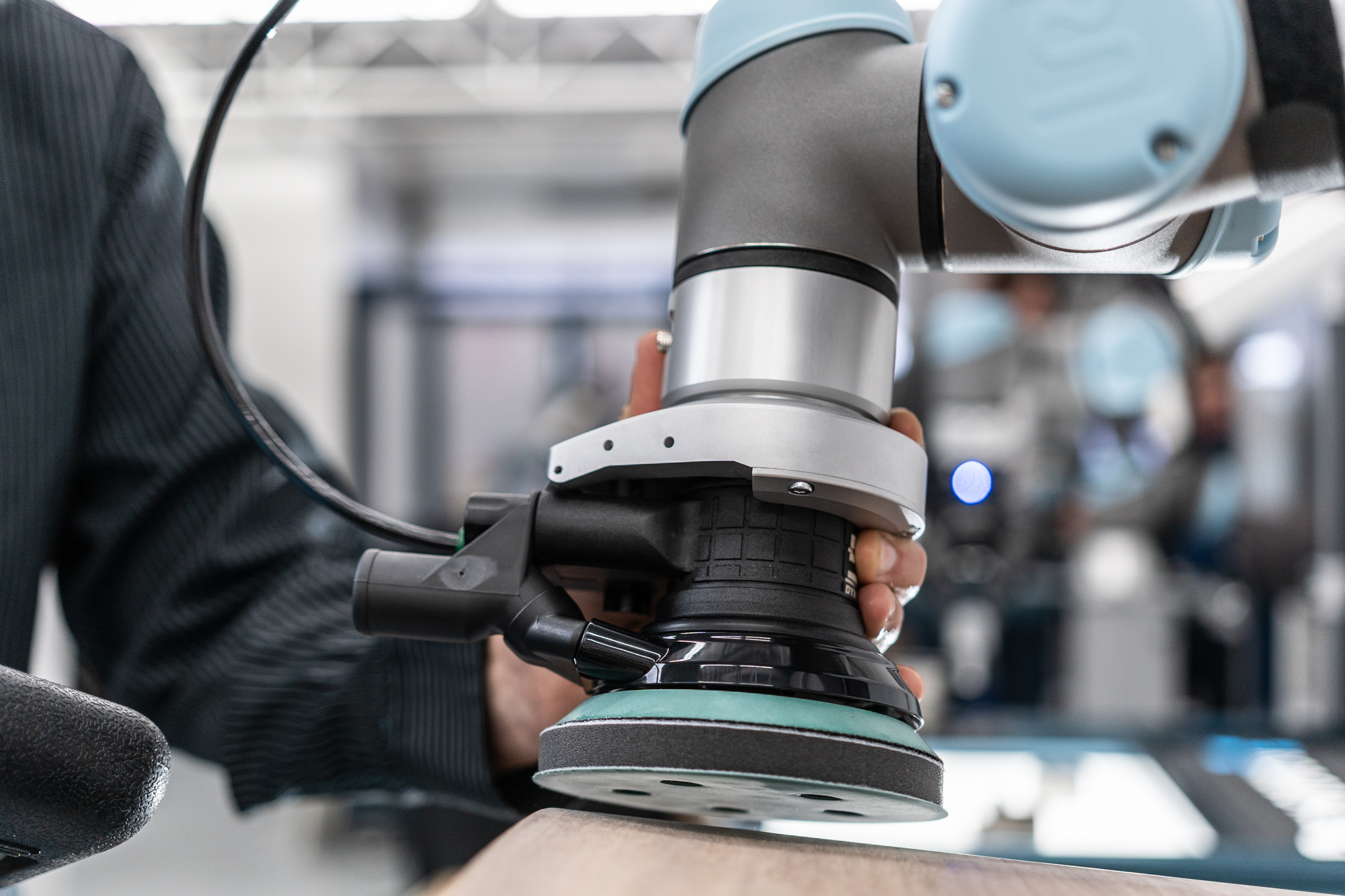What's New in Robotics This Week - Jun 10

Posted on Jun 10, 2016 7:00 AM. 9 min read time
DHL's cobot pilot; Luggage check bot; Robots on a mission; US Congress discusses robotics; AI off switch; Siemens developing cobots; What is a robot?... and much more! Find out what's happening in our robotics universe this week. We hope that the news we have selected will interest and amuse you. Enjoy!
DHL Supply Chain Runs Warehouse Pilot with Collaborative Robots (Post and Parcel)
DHL Supply Chain revealed this week that it has been running a pilot test for collaborative robot order picking at one of its warehouses in Unna, Germany.
The pilot involves two EffiBOT automated trolleys (developed by French start-up Effidence) that can follow human pickers through the warehouse, carrying items and dropping off orders.
The robots gave staff the freedom to work “hands-free” and meant that they did not have to push or pull heavy carts.
“The picking cart follows the picker through the rack system. Once it reaches full capacity, the picker simply sends it to the designated drop-off location, while another picking cart joins. This solution makes moving from single to multi-order picking a more efficient and ergonomic process,” explained Michael Artinger, Site Manager DHL Supply Chain, who was responsible for the test.
In addition to EffiBOT, collaborative robots for “value-added services” such as co-packing as well as mobile piece picking robots autonomously navigating through warehouse shelves are also being tested by DHL.
Reduced inventories and increased online shopping mean increased picking processes and a huge challenge for the logistics sector, so it will be fascinating to see how this pilot works out.
See more from DHL.
There’s Now a Robot that Can Check Your Bags at Geneva Airport (Quartz)
BlueBotics and SITA (a Swiss telecoms firm specializing in the air transport industry) have teamed up to create Leo, a robot that can check your luggage at the curb.
To use the bot, passengers with luggage tap a few buttons on Leo’s touchscreen, scan their boarding passes, drop their bags in its cargo bay, and affix the luggage tags that Leo prints out. The bot then closes up its cargo area—so that no one can tamper with your bag while it’s in transit—and drops the bags off at a loading station, where a human drops the bags on a conveyor belt to be scanned and loaded onto the correct plane.
Leo can carry two bags, weighing up to 32kg (70lb), and, according to SITA, can get from the drop-off area of the airport to the luggage loading zone on its own, avoiding any people that might be rushing to catch flights while it putters around.
Frankly, anything that makes the flying experience less stressful is to be welcomed.
Research Details Developments in the Global Collaborative Robots Market (WhaTech)
Robots have tapped in electrical & electronics industry and the applications are always expanding. Driven by global competition and the rising consumption of electronic products, collaborative robots market in electrical & electronics industry is expected to witness phenomenal growth, with annual shipment and sales revenue from hardware and software growing at over 42% annually through 2022.
Robots on a Mission: Agents of Change in Manufacturing (Forbes)
In a fascinating opinion piece for Forbes, Jim Lawton, Rethink Robotics' Chief Product and Marketing Officer, looks at the hardware and software advances that will enable manufacturing robots of the future to perform more --and more complicated-- tasks than ever before.
The integration of hardware and software will raise the robots’ ability to understand what needs to be done and execute the physical steps required to make it happen. They will direct activities and equipment in the workcell. They will learn from their work – and the work of robots globally, collect information on their performance and provide data analysis that can inform continuous process improvement.
U.S. Congress Discusses AI, Automation, Robotics and Basic Income (Envienta Association)
It's great to see national policy makers discussing issues around robotics. It will fall to policy makers around the globe to create the legislative environment under which various robotics technologies will survive, thrive, or fail. It's also a mark of how far robotics has come over recent years. No longer abstract, futuristic technologies, robots have entered the mainstream and lawmakers are paying attention.
Most large organizations, whether corporations or governments, are famously (or infamously) reactive rather than proactive. Is there any chance our global societies will prepare sufficiently to make this upcoming transition a smooth one or are we potentially facing some rough seas ahead? What are the major hurdles we’ll need to get over if we want to minimize disruption?
Google Doesn't Want to Accidentally Make Skynet, so it's Creating an AI Off Switch (Gizmodo)
Google’s DeepMind and Oxford University’s Future of Humanity Institute, have collaborated on a paper (titled “Safely Interruptible Agents”) that investigates how to turn off an artificial intelligence if it starts doing something its human operator doesn’t want it to do. In essence, it's a big red button for AIs.
The researchers have seen the same movies you have. You know, the one where the robot learns to ignore a turn-off command. They’re prepared for that.
This paper explores a way to make sure a learning agent will not learn to prevent (or seek!) being interrupted by the environment or a human operator.
Siemens is Building an Army of Collaborative Spider Robot Factory Workers (Fast Company)
Siemens is developing a swarm of general-purpose industrial robots that can work together in order to figure out how to handle new tasks.
Dalloro's [Head of research for Siemens Corporate Technology] team at Siemens's lab in Princeton, New Jersey, has built spider-like 3-D printers that crawl around as a coordinated team.
Looking like an arachnid Wall-E wearing a fez, each bot has a head with a 3-D depth-sensing camera similar to an Xbox Kinect. On top of that is an infrared laser scanner to further gauge the surroundings. Off-the-shelf circuit boards running Linux on multicore CPUs handle tasks like analyzing the immediate terrain.
The spiders chat over Wi-Fi and Bluetooth, reporting how much ground each can cover so that their collective mind can break up the job and assign out portions of it.
This 28-Year Old Geneticist Has Created a Robot from DNA and Proteins (Vice)
This new wonder, baptized 'Eligobiotique', has already been tested successfully on mice that carried an ultra-resistant version of staphylococcus aureus – one of the deadliest bacteria in the world. Eligobiotiques could also be 'reprogrammed' to get rid of the bacteria responsible for bowel inflammation and eradicate Crohn's disease or acne. If this product turns out to be efficient, it could be used on any pathology linked to the microbiota, such as diabetes and certain types of cancer. So far, 2.4 million euros have been invested in the project and researchers are currently preparing the product to enter the market: the Eligo robot could appear in pharmacies in about seven years.
U of Washington Tech Policy Lab Answers the Question: What is a Robot? (Robohub)
You think you know what a robot is until you have to define it exactly. Sensing, actuation, and intelligence are key, but in what proportions, and must all three be present in every case?
For law makers, insurers, and the business world, these definitions are extremely important, so the Tech Policy Lab at the University of Washington produced the above video as its contribution to a very interesting discussion.
And Finally...
The key to human-robot relationships is vocalization, says Carnegie Mellon (TechRepublic)
World's first child-exoskeleton for spinal muscular atrophy (ScienceDaily)
AME invests in collaborative robot technology (Works Management)
World's first passenger drone cleared for testing in Nevada (The Guardian)
Robots are invading malls (And Sidewalks) near you (MIT Technology Review)
Stanford university team teaching robots to be polite (ABC7 News)












Leave a comment